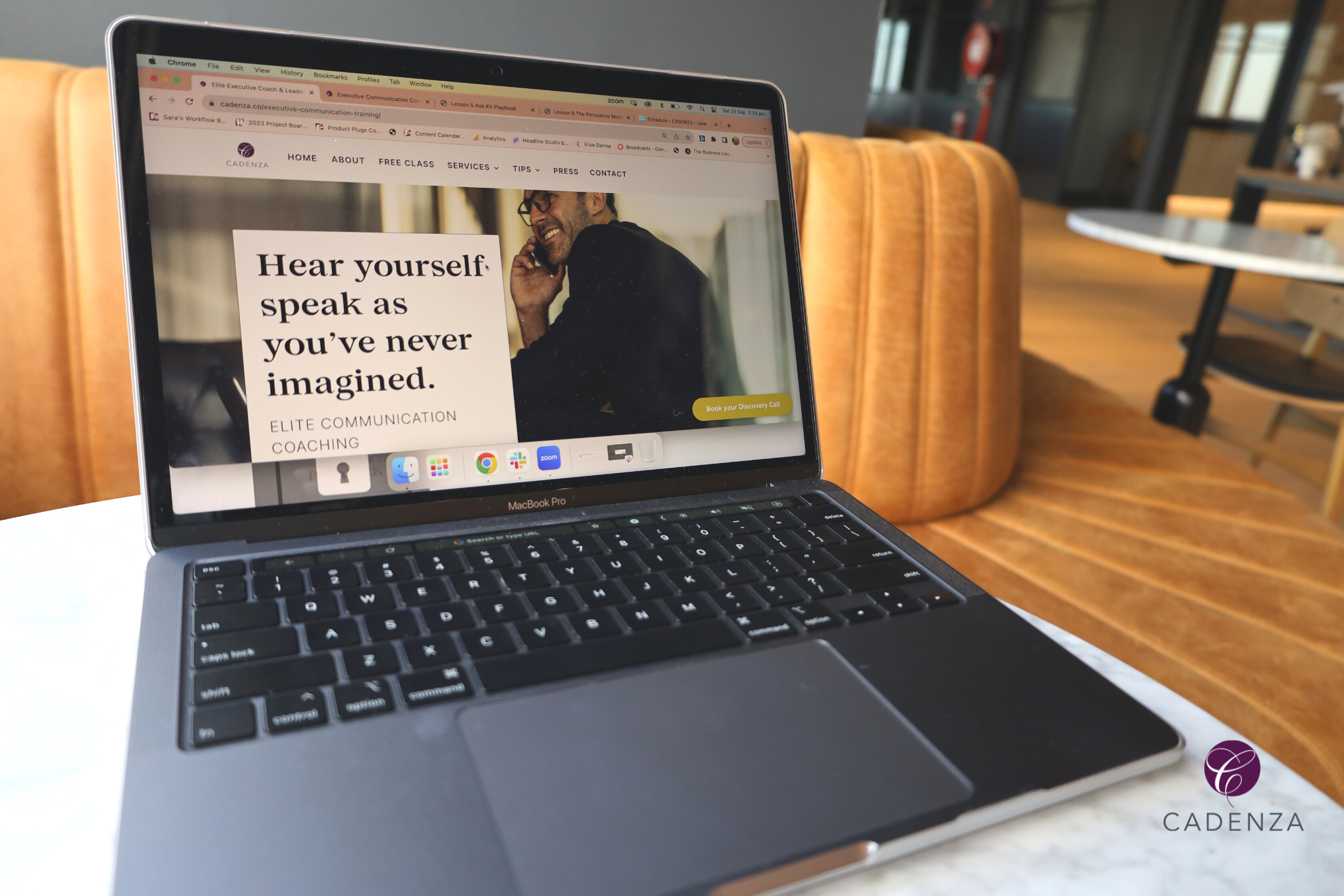CEO Communication
5 Communication Activities CEOs can Use to Influence Organisational Behaviour
Learn how you, as a CEO or founder can optimise organisational behaviour with 5 elite communication activities that inspire action & scaling.

Prosperous organisations begin with the founder’s vision. What happens between their genesis and lifespan depends on the leader’s ability to set the modus operandi of the organisational machine. The process relies on optimising organisational behaviour and is contingent on the CEO or founder’s capacity to communicate what the company needs in a way that achieves desired actions.
This article is best digested in 3 parts:
- Check the tips for summarised below
- Watch the vlog for more detailed training.
- If you want to optimise your voice tone, boost your speaking & express yourself clearly, sign up for the Executive Communication Training only with Cadenza.
The great American billionaire investor Ray Dalio recommends building an organisation from the top down. This article will provide a range of business communication solutions you can use as a CEO or founder intent on scaling your organisation to achieve measurable results.
Organisational Change is a Requirement for Scaling your business; its success depends on business communication strategies.
– CADENZA
Change management without strategic communications, for want of a better metaphor, is patting the cat backwards.
But what if there were concrete communication activities that the CEO or founder could rely on to reduce abrasion and align the human capital to the capital vision?
Organisations that seek to innovate will encounter resistance from their employees, which will cause a barrier to successful implementation if ignored (Dorling, 2017).
Research conducted in 2016 by Dorling concluded that there are 3 reaction pathways that employees take when presented with change or new ideas:
- Passivity
- Honesty
- Aggression
A leader must be prepared to manage these reactions with a balance of social intelligence and impeccable communication to support operational success and endear the team to become change adopters rather than saboteurs.
The playbook for organisational transformation reads like a propaganda campaign. Visionary leaders can structure new and ideal solutions in an organisation and win with their team. Still, only the elite communicators can propagate shifts around the rules of play in an organisation and get the game started.
So if you’re in a position where you need to realign your organisation’s processes, policies or systems, consider this vital 3-step framework.
- Strategy development to generate change and innovation
- Communication campaign to influence your talent to adopt the change
- Ongoing implementation of new processes, policies or systems through advanced interpersonal communication strategies to retain talent, restrict risk and protect your reputation
Let’s now investigate five communication activities you can deploy as a CEO, Founder or Leader to influence organisational behaviour.

#1 Plan for Operation Change Conversations with your Key Employees if you Refine the Organisational Chart
An organisational chart may need modification to keep up with the organisation’s growth trajectory. When you refine the organisational chart, positioning the heads of departments will always profoundly impact your individual team member’s perceptions around their access to autonomy and reward.
Strategic positioning of leaders throughout the organisational departments needs to be held accountable to the organisation’s needs, which will increase risks to your reputation management as the figurehead. New appointments must be growth predictors, not based on feeding the politics, because concrete outcomes do not arise from favours and barters. Refining your organisational chart will bring fallout that can only be mitigated through an emotionally intelligent communications process. In this instance, the founder has no directive to appease the employees regarding how they structure the future workhorse for the organisation; they are accountable to the bottom line, the market appetite and shareholders. However, efforts to undertake personalised operational change conversations with key employees to mitigate risk will ameliorate the process.
At Cadenza, we can assist you in positioning operational change messages to optimise organisational behaviour by partnering with you to strategise persuasive conversations that optimise rapport, engagement and retention in the height of change. The latest research into corporate communication informs all methods to result in rigorous solutions for your organisation’s next iteration.
#2 Consider delivering a transformative presentation to key personnel to vision cast
As the figurehead of your organisation, your role as CEO, Founder or Leader is to inspire vision. One of the most effective ways to increase behavioural change in your organisation is to incorporate a charismatic presentation as a critical step in your strategic communications.
A polished, eloquent, charismatic presentation can create a memorable hook point for the organisation, spurring action and easing adoption if strategically prepared.
The content of such a presentation should consider various elements, supported through skilful communication devices like unique metaphors, captivating stories and rapport-building strategies to encourage resonance and relevance for the audience.
The organisation’s workings and future may play a loop in your mind but don’t expect your key players to know the extent of the dreams they need to actualise if you don’t cast the vision.
Content, tone and presentation style deserve detailed consideration to protect your reputation management. Likewise, the timing, audience and communication strategies preceding and following the presentation must be timed and calculated. A presentation alone will not get the traction you’re aspiring for. However, a presentation embedded strategically into a clear communication campaign is likely to influence change adoption and innovation.
At Cadenza, we can assist you in determining your presentation’s positioning, hook points and structure alongside vital performance strategies to increase your chance of charismatic delivery using social intelligence structures and tactical charisma training. We can assist you with refining your speech, storytelling and tone to achieve a transformational presentation that encourages employee buy-in.

#3 Select your early adopters and endear them with a persuasive campaign
While most organisations will have change-seeking team members, most will be adverse. Consider your crucial personnel around you and consider deploying a persuasive campaign to harness mutuality and alignment by priming them for pending change or innovation. Garnering an entourage of individuals you can influence is advisable before addressing the greater body. Preliminary manoeuvres like this will provide more data on possible pushback, risk and reputation pitfalls that may arise once you share your directives with a broader audience.
At Cadenza, we can assist you in developing the right words to say with each specific contact you deem appropriate for deploying increased influence and isolate the minimum you need to say to get the maximal outcomes.
Our work in this area will allow you to develop the tools to address objections, take on critical feedback, and hypothesise more profound interpersonal risks with total composure and clarity of thought.
#4 Organisational behaviour will be influenced by the questions you’re asked- the more you get, the better
By virtue of their hierarchy, CEOs, Founders and Leaders run the risk of entrapment in an echo chamber. Strategy awaits if your directives are met with blank faces, limited feedback or ambiguous reactions.
While a leader can pull rank, positive organisational behaviour needs dialogue.
Granted, most founders and CEOs have limited time for extensive conversational exchanges throughout a vast cross-section of their organisation. Workflow demands should not impede information gathering.
One of the most effective ways to gain insight into the organisational culture and personnel around you is to incorporate tactical conversational frameworks and exchanges that encourage inquiry from your team. Such activities allow you to gain the detailed information needed to enable critical predictors that could jeopardise or endear your team in adopting change and innovations. Various tools can assist, such as insight surveys and conversational scaffolding devices (that help you create conversations that enable team members to provide structured feedback within your set limits).
At Cadenza, we can assist you in priming your message and conversations to encourage increased dialogue so that you can gain concrete evidence of the temperature in the room.
We use a variety of science-backed frameworks for CEOs and Founders that help you harness the flow of information so that it is action-focused, keeping your conversations efficient, on topic, and in alignment with your critical agenda.
#5 Communication Freshness Strategies
If we were to analyse a leader’s communication in a lab, we’d see that various elements around the leader catalyse their atomic potential or deplete their energy level. Management communication goals can give you energy and clarity as a leader when you most need it.
In most cases, a CEO, leader and founder ascends to the upper levels of the hierarchy powered by the force of charismatic communication, cognitive clarity and sharp acumen. However, the workload, responsibilities and risks associated with executive tenureship can jeopardise the leader’s capacity to communicate clearly, interact charismatically and engage adroitly.
A lot can be said for how to streamline your speaking skills as a CEO, Leader or Founder to guarantee fast and agile communication responses.
At Cadenza, we assist CEOs in optimising their already solid management communication skills to synchronise tactical messages if sleep-deprived, time-poor or work load burdened.
If you can position tactful responses in the heat of the moment, you’ll showcase intent-based leadership and spur team action. If you’re trailing into long-winded rants or stress-fueled interactions with your team, you’re losing impact because you’re so compressed that your brain is in overdrive. When we deliver executive communication training to Executives, Founders and CEOs, we train our clients in proven plug-and-play formats. Using our research-informed systems, you can deliver concise, emotionally intelligent statements to your team and stakeholders so that your good intentions and reputation are protected even when the work ratio is out of balance.

As a business evolves into a larger organisation, the workhorse’s parts, components, and functions must adapt. Agile and innovative solutions can be envisioned by the business mastermind (usually the CEO or a COO); however, without the communication strategy to deploy effective change management, the humans it affects can not only stop but even sabotage the desired course of progress. Corporate communication strategy is a vital investment to protect each touchpoint across the organisation, providing a driving force for successful ventures, company growth potential and marketplace success.
Humans that speak well under pressure, solve problems better under pressure. At Cadenza, we can help you to:
- Enhance your leadership communication skills, reputation management and presentation skills
- Develop your team’s communication abilities
Want to learn more?

Optimise your Voice Tone, Boost Your Speaking & Express yourself Clearly.
EXECUTIVE COMMUNICATION TRAINING IN MELBOURNE OR ONLINE
Do you wish you could think on your feet and speak on a roll?
Executive consulting at CADENZA has been designed to offer validated executive communication training designed for CEOs, Founders & Leaders.
Our extensive tricks are not only research-backed; they work to sharpen your communication agility drastically so that people can’t wait to hear what you have to say.
If you’re an executive, emerging leader or an ambitious person who wants to get ahead professionally, we can help with that. Our team assist emerging leaders, CEOs and executives speak with an eloquent, confident voice tone. In your Executive leadership communication sessions, you’ll learn how to juggle your interactions, so your words and message align with your audience and build relationships, trust and impact.
References
-
Alblooshi, M., et al. (2020). “The relationship between leadership styles and organisational innovation: A systematic literature review and narrative synthesis.” European Journal of Innovation Management ahead-of-print.
-
Castillo, Cristian & Fernandez, Vicenc & Sallan, Jose. (2018). The six emotional stages of organizational change. Journal of Organizational Change Management. 31. 468-493. 10.1108/JOCM-05-2016-0084.
-
Dorling, J. L. (2017). Impact of psychological capital on the resistance to change during postmerger integration. Journal of Organizational Change Management, 30(6), 936-956. doi:10.1108/JOCM-11-2015-0199.
-
Shivani Gupta, & Dr. Anju Singla. (2017). Organizational Change and Job Satisfaction: An Analysis of Mediating Effect of Organizational Trust. Indian Journal of Commerce and Management Studies, 7(3), 07–13. Retrieved from https://www.ijcms.in/index.php/ijcms/article/view/245
-
Sürücü, L. (2021). “Transformational Leadership, Organizational Justice and Organizational Citizenship Behavior.” Akademik Araştırmalar ve Çalışmalar Dergisi (AKAD) 13: 429-440.
-
Hassan Elsan Mansaray. The Role of Leadership Style in Organisational Change Management: A Literature Review, Journal of Human Resource Management. Volume 7, Issue 1, March 2019 , pp. 18-31. doi: 10.11648/j.jhrm.20190701.13
Did you enjoy this post? Make sure to subscribe to our YouTube channel to get more content to increase your communication skills!
About the Author
Dr Sarah Lobegeiger de Rodriguez is a Keynote Speaker, Executive Speaking Coach, and Opera Singer who likes to play with words, sounds, and your impact.
Her academic background is in Music Performance, Communication Science and Speech & Language Pathology. She assists executive communication clients all over the world as a communication consultant with strong expertise in CEO, Founder and Entrepreneur communication strategies.
Connect with Sarah on LinkedIn.
© CADENZA
Level 14, 380 St Kilda Road, Melbourne, 3004
Privacy Policy
Terms & Conditions
Position Statement on Racism

